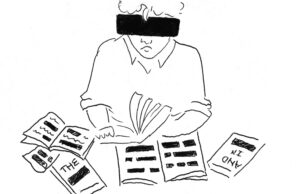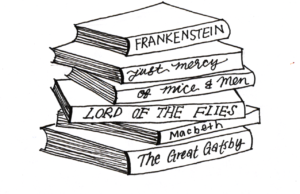Required Book Review

It’s a familiar feeling in English class: that wary feeling of being assigned novels and plays. Students’ natural instinct tells them to rebel against this forced reading and resort to Sparknotes, but it turns out that some books are worth the attention after all, while others only deserve the dark home of the bottom of a backpack. Romeo and Juliet, Frankenstein and The Great Gatsby are just some of these well-known school reads. Are they worth it?
Romeo and Juliet (9th grade) – Samantha Meyer
As one of the most iconic and influential works ever written, Romeo and Juliet, by William Shakespeare, holds high expectations for students with a love for all things romantic, tragic, or classic, and is dreaded by those who would rather sew their eyelids closed than read one word of Shakespearean language. Nevertheless, because of the constant allusions and similar storylines that have stemmed from it into today’s pop culture, there is a certain anticipation that comes with the title. And its anticipation is deserved. Although the play starts off slowly, with the introduction of the characters, the explanation of the infamous feud between the Capulets and the Montagues, and Romeo’s incessant whining over his unrequited love for Rosaline, it soon picks up. The language starts to become easier to digest, it’s both interesting and entertaining to dive into the “true love”, passion and angst the characters face at such a young age, as well as the tragic and unnecessary consequences that come from following their hearts. Think of any hour-long drama with a love triangle, secrets and the occasional fist fight, and you have Romeo and Juliet. (Leonardo DiCaprio also plays Romeo in the 1996 film adaptation, which is obviously a huge plus.)
Frankenstein (10th grade) – Victoria Juan
Frankenstein is possibly the most painfully hilarious required novel of high school, with writing that reflects Charles Dickens’s intricacy but not his sophistication. Written by Mary Shelley, the story follows the plight of Dr. Frankenstein as he struggles to escape the pursuit of a monster sewn out of mismatched body parts that he himself brought to life. The further Frankenstein tries to run away, the more destructive the monster becomes, killing his creator’s closest family members in an attempt to attract his attention and love. Aside from forcing students to adjust to the fact that the monster is not actually called “Frankenstein” as many Halloweens have taught, Frankenstein provides an immensely difficult time in analysis because its characters are so static and long-winded in their thoughts, and literary devices like allusions and imagery are poorly, blatantly written. Shelley’s doctor and monster are both merely emotional wrecks that effuse the existential crisis of the Romantic period throughout the whole story. Expect a snore-worthy, eye-burning, “why-would-you-ever-do-that” read.
The Great Gatsby (11th grade) – Michael Hellard
The Great Gatsby, written in 1925 by F. Scott Fitzgerald, is one of the most hyped and revered books during most student’s entire education. It follows young stockbroker Nick Carraway after he moves to Long Island, New York. His story unfolds as he becomes wrapped up in the life of the mysterious Jay Gatsby, a next-door millionaire, and his relationship with Nick’s cousin Daisy. Nick quickly becomes accustomed to the glamorous lifestyle of the rich and the costs it has on people. With five movies (the first being made not a year after the book’s release) and the source of references across popular culture, it is possible to have heard the story before reading the book. The novel, however, is both a time capsule of the roaring twenties and a fascinating tale of the American Dream in a way that other interpretations never can be. Fitzgerald combines elegant yet simple writing with a unique story of mystery, romance, and character to create a read unlike any other. While many students fear the novel may be outdated and irrelevant, it is rare that they are not engulfed and pleased by the end.



